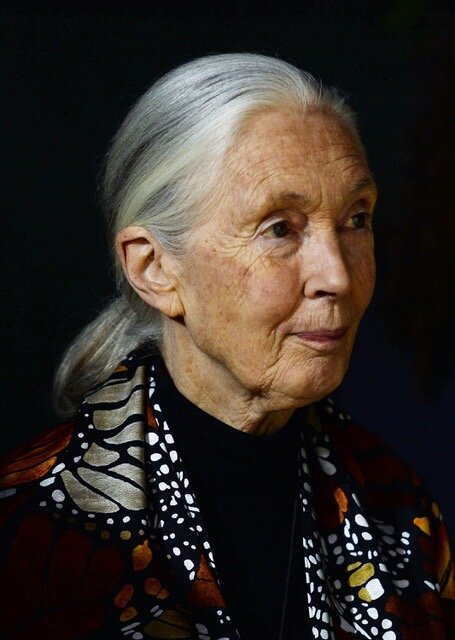What Makes Me Hopeful
1960s Jane Goodall at Gombe Reserve in Tanzania.
Jane Goodall has inspired me for decades. In 1970 I returned from three years as a Peace Corps Volunteer in Thailand. My first job back in the States was teaching 9th-grade geography at a JHS in Bellevue, Nebraska. To bring geography alive for my students, I covered the walls with maps and posters, kept atlases handy at every desk, and brought the world into my classroom visually through films ordered from the National Geographic Society.
With my 9th grade geography students at Audubon JHS, Los Angeles in 1986.
That is how Jane Goodall and her research came into my classroom. Ten years earlier, at the age of 26, she had traveled from England to Gombe, Tanzania to begin what has become a 60-year study of wild chimpanzees. The National Geographic Society published Among the Wild Chimpanzees—a book as well as an educational film about Goodall’s primate research at Tanzania’s Gombe Reserve. While viewing the film with my students, I felt as if I were with her in the forest at the edge of a clearing, watching the chimpanzees preen, use tools, and gradually begin to trust and interact with her.
Describing her research at Gombe, Goodall said, “A sense of calm came over me. More and more often I found myself thinking, this is where I belong. This is what I came into this world to do.”
In 1974, I moved to Los Angeles and for the next 13 years taught geography at Audubon JHS. A year after arriving, I met Kit, and together we began a collaboration with the National Geographic society to improve the teaching of K-12 geography across the country. While in Washington, D.C., we heard Dr. Goodall speak about her groundbreaking 60-year mission. She emphasized the urgent need to protect chimpanzees from extinction, and she redefined species conservation to include the needs of local people and the environment.
These days, Dr. Goodall travels the world speaking about threats to chimpanzees and the global environmental crises. As the founder of The Jane Goodall Institute and a United Nations Messenger of Peace, she has shaped attitudes and policies on human rights and the climate crisis while encouraging each of us to take action on behalf of all living things and our shared planet. Recently she was a guest of food writer Mark Bittman as part of his Bittman Project series.
When Bittman asked her how conservation efforts can succeed, Dr. Goodall responded, “Unless you involve the local people, whose land it really is, no conservation work will succeed.” Asked what makes her hopeful, Goodall replied, “What the youth are doing (today) is incredibly hopeful. As I was traveling around the world, before the pandemic, everywhere I was meeting amazing people doing incredible projects—restoring fertility to overused farmland, like we did, around Gombe, restoring a forest—bringing back life and nature, to a place we’ve destroyed. Rescuing animals from the brink of extinction. We’ve got this indomitable spirit, we’re going to tackle things that seem impossible, and we won’t give up. Nature is amazingly resilient if you give her a chance.”
Dr. Jane Goodall today.
Given the violence, divisiveness, and distrust of science in today’s world, it is easy to lose hope. In her July 18 “Letters From an American” post, historian Heather Cox Richardson reminded her readers of Georgia Representative John Lewis who passed away a year ago at 80 years old. Throughout his life, he fought for change against formidable odds. Richardson wrote: “As a young adult, Lewis was a ‘troublemaker,’ breaking the laws of his state: the laws upholding racial segregation. He organized voting registration drives and in 1960 was one of the thirteen original Freedom Riders, white and Black students traveling together from Washington, D.C. to New Orleans to challenge segregation.”
1960 was the same year that Jane Goodall flew to Tanzania and dedicated her life to shaping minds and bringing about global change. Over the course of Lewis’s life as a nonviolent activist for legislation to protect voting rights in America, he was beaten by police troops, jailed 23 times, helped organize the 1963 March on Washington, and was elected to the United States House of Representatives, winning reelection 16 times. His actions inspired President Lyndon Baines Johnson to pass the 1965 Voting Rights Act. Eight years ago, Lewis saw that historic legislation gutted by the Supreme Court’s 2013 Shelby County v. Holder decision—a decision that took away Department of Justice supervision of election changes in states with a history of racial discrimination. On the one-year anniversary of Lewis’s death, Richardson’s July 18 blog noted: “As of mid-June 2021, 17 states had passed 28 laws making it harder to vote, while more bills continue to move forward.”
Rep. John Lewis receiving the Medal of Freedom Award in 2011 from President Barack Obama.
How did John Lewis keep hope alive? Like Dr. Goodall, he believed “We must use our time and our space on this little planet that we call Earth to make a lasting contribution, to leave it a little better than we found it, and now that need is greater than ever before…. Do not get lost in a sea of despair. Do not become bitter or hostile. Be hopeful, be optimistic. Never, ever be afraid to make some noise and get in good trouble, necessary trouble. We will find a way to make a way out of no way.”
The actions and lifelong dedication of Jane Goodall and John Lewis continue to inspire me and give me hope. They remind me that the future of our democracy and the health of our shared planet demand that each of us do something. As John Lewis said, “It’s time to speaking up and speaking out.”



